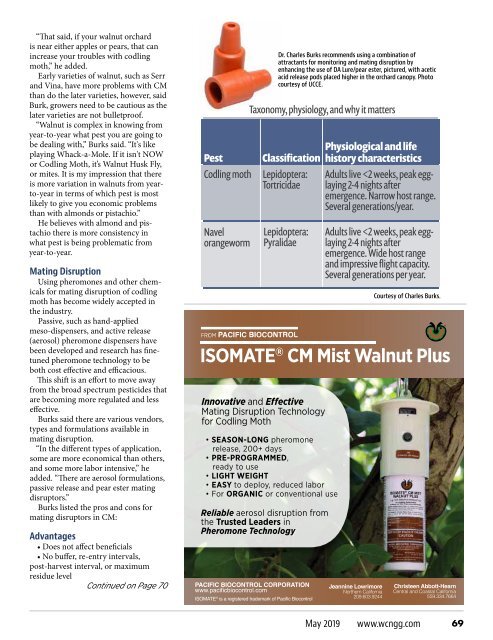May 2019 WCN Digital Edition
Create successful ePaper yourself
Turn your PDF publications into a flip-book with our unique Google optimized e-Paper software.
“That said, if your walnut orchard<br />
is near either apples or pears, that can<br />
increase your troubles with codling<br />
moth,” he added.<br />
Early varieties of walnut, such as Serr<br />
and Vina, have more problems with CM<br />
than do the later varieties, however, said<br />
Burk, growers need to be cautious as the<br />
later varieties are not bulletproof.<br />
“Walnut is complex in knowing from<br />
year-to-year what pest you are going to<br />
be dealing with,” Burks said. “It's like<br />
playing Whack-a-Mole. If it isn't NOW<br />
or Codling Moth, it’s Walnut Husk Fly,<br />
or mites. It is my impression that there<br />
is more variation in walnuts from yearto-year<br />
in terms of which pest is most<br />
likely to give you economic problems<br />
than with almonds or pistachio.”<br />
He believes with almond and pistachio<br />
there is more consistency in<br />
what pest is being problematic from<br />
year-to-year.<br />
Mating Disruption<br />
Using pheromones and other chemicals<br />
for mating disruption of codling<br />
moth has become widely accepted in<br />
the industry.<br />
Passive, such as hand-applied<br />
meso-dispensers, and active release<br />
(aerosol) pheromone dispensers have<br />
been developed and research has finetuned<br />
pheromone technology to be<br />
both cost effective and efficacious.<br />
This shift is an effort to move away<br />
from the broad spectrum pesticides that<br />
are becoming more regulated and less<br />
effective.<br />
Burks said there are various vendors,<br />
types and formulations available in<br />
mating disruption.<br />
“In the different types of application,<br />
some are more economical than others,<br />
and some more labor intensive,” he<br />
added. “There are aerosol formulations,<br />
passive release and pear ester mating<br />
disruptors.”<br />
Burks listed the pros and cons for<br />
mating disruptors in CM:<br />
Advantages<br />
• Does not affect beneficials<br />
• No buffer, re-entry intervals,<br />
post-harvest interval, or maximum<br />
residue level<br />
Continued on Page 70<br />
Pest<br />
Codling moth<br />
Navel<br />
orangeworm<br />
Dr. Charles Burks recommends using a combination of<br />
attractants for monitoring and mating disruption by<br />
enhancing the use of DA Lure/pear ester, pictured, with acetic<br />
acid release pods placed higher in the orchard canopy. Photo<br />
courtesy of UCCE.<br />
Taxonomy, physiology, and why it matters<br />
Classification<br />
Lepidoptera:<br />
Tortricidae<br />
Lepidoptera:<br />
Pyralidae<br />
Physiological and life<br />
history characteristics<br />
Adults live


















